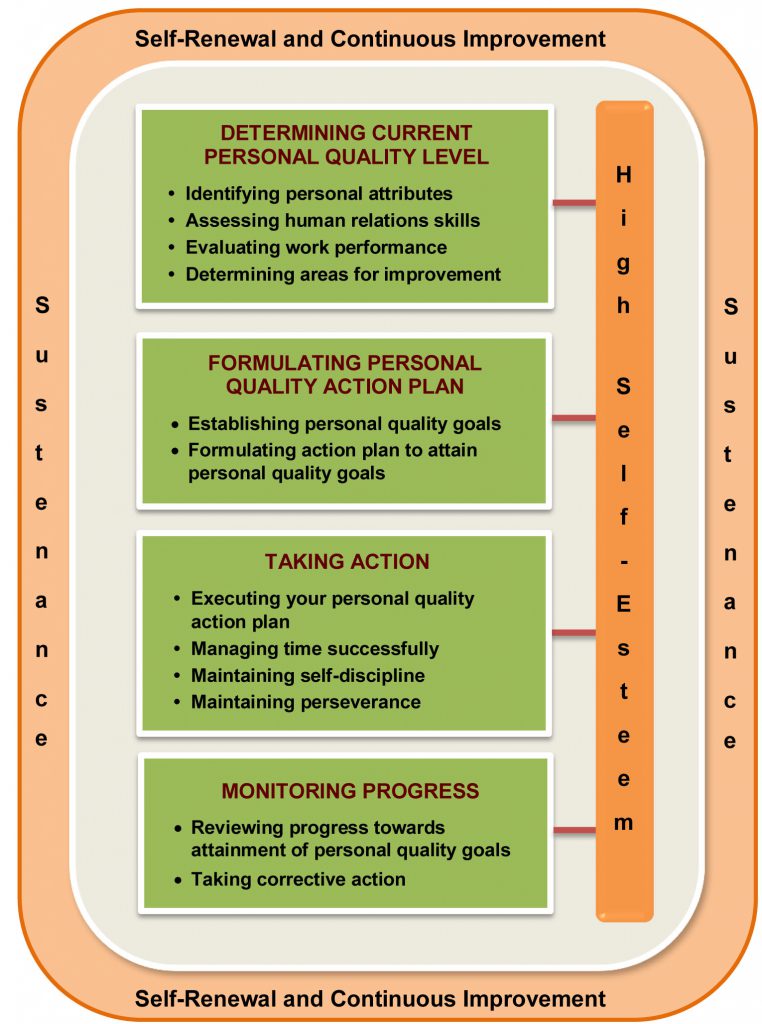Based upon our consulting and training experiences, the quest for creating and sustaining a High-Performance Organization should be based on the Systems Approach (see Figure 1). It views an organization as a set of interdependent and interrelated elements or subsystems, each of which contributes to the attainment of common organizational goals. Changes in any one subsystem will have an impact on the other subsystems. As such, all the subsystems must be integrated into a functional whole to ensure total organizational functioning.
The Systems Approach also views an organization as an open system interacting with its environment and transforming inputs (resources such as materials, people and equipment) into outputs (products and services) desired by customers.

Figure 1: Systems Approach to Organizational Improvement
1. Social System
Corporate culture
- Personal quality
- Employee participation and teamwork
- Empowerment
- Reward and recognition system
- Communication
2. Technical System
- Technology
- Work processes
- Decision-making processes
- Job definition and responsibilities
3. Management System
- Strategic quality planning
- Leadership
- Policies
- Organizational structure
- Managerial control
Creating and Sustaining a High-Performance Organization Model
The following model (Figure 2) based upon the Systems Approach, best practices in management, and strategic planning is suggested for creating and sustaining high performance in organizations. It consists of five major steps:
- Getting Organized.
- Organizational Diagnosis.
- Organizational Transformation Plan.
- Implementation.
- Measurement and Evaluation.

Figure 2: Creating and Sustaining a High-Performance Organization Model
Getting Organized
The main purpose of Step 1 is to lay the basic foundation for ensuring successful implementation of organizational improvement efforts. It involves establishing an Organizational Transformation Team (OTT) consisting of senior, competent and highly committed managers which will spearhead the organizational improvement efforts. The OTT should agree on three major issues as highlighted by James Champy: (i) the business case for the change (Why must we go through this?”); (ii) the scope and scale of the change (“What processes are we going to reengineer?” or “How much of the business must change?”); and (iii) the governance process for managing the change (“Who will be accountable for the design and for the results?”).
Three other important activities in Step 1 are clarifying stakeholders’ expectations, communicating the need for organizational improvement to all employees and securing the support of key players. Organizational success in the long run is greatly dependent upon meeting or exceeding the expectations of an organization’s primary stakeholders, particularly its customers, shareholders, employees and suppliers. Organizational improvement awareness (establishing a great enough sense of urgency about the need for change) is necessary to gain support of employees for the improvement efforts and reducing potential resistance to change. The support of key players is crucial for ensuring successful change management.
Organizational Diagnosis
Organizational diagnosis is a systematic approach to developing an accurate and comprehensive view of the current state of the organization. It provides a basis for determining action plans to improve organizational performance. Organizational diagnosis is also important because it assesses the readiness and capability of major subsystems to undertake organizational improvement efforts. The major activities are:
- Scanning the internal environment for organizational strengths and weaknesses, and the external environment for opportunities and threats (SWOT analysis);
- Identifying key business processes and opportunities for improvement;
- Benchmarking against high-performance organizations; and
- Conducting customer and employee opinion surveys.
Organizational Transformation Plan
The Organizational Transformation Plan expresses clearly the desired future state of the organization and the necessary actions to attain it. It comprises the organizational mission statement, corporate and departmental goals, strategies for attaining goals, performance standards, appropriate organizational structure and ways of empowering and motivating employees. The Organizational Transformation Plan is important as it clarifies for all employees the performance goals and what needs to be done to attain them.
Implementation
Step 4 involves implementation of projects identified in the Organizational Transformation Plan. The two most important activities are aligning structure, processes and systems to organizational strategy, and process control i.e. detection and correction of nonconformances to established requirements. The other important activities are coordinating the performance improvement efforts among the various departments and maintaining effective communication.
Measurement and Evaluation
The major purpose of Step 5 is to determine progress towards the attainment of established performance goals. The main activities are measurement, reporting of results to all employees and undertaking corrective actions to overcome performance gaps.
Training and Teamwork
Training and teamwork pervades the entire HPO Model. Training is essential at the initial stage to secure organizational commitment to performance improvement and to minimize resistance to change. Appropriate training subsequently must be continuous to ensure employees have the necessary knowledge and skills to cope with changes in technology and the environment in which the organization operates.
Teamwork is important as it creates a sense of ownership and commitment among employees. Employees are generally more willing to support performance improvement efforts in which they have taken part or helped to develop. Teamwork is also based on the premise that collective wisdom is generally more superior to individual wisdom. Teamwork also facilitates solution of performance problems which cut across departmental or functional boundaries.
Healthy Organizational Culture
An appropriate organizational culture is necessary to create and sustain a work environment that is conducive to continuous performance improvement efforts. Organizational culture is basically a set of shared values and beliefs which interact with an organization’s people, structures and systems to produce behavioural norms. The principal values of a healthy corporate culture include customer focus, “doing things right the first time”, employee autonomy, teamwork, recognition based on attainment of performance goals, open and honest communication, continuous improvement and flexibility (adapting to the changing environment).